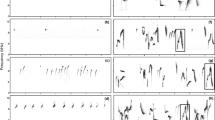Abstract
We examined recognition of individual neighbors in hooded warblers (Wilsonia citrina) and Kentucky warblers (Oporornis formosus) by comparing responses to playbacks of neighbors' songs from appropriate and inappropriate boundaries of the subjects' territories. Kentucky warblers, which sing one song type each, responded more strongly to the songs of neighbors broadcast from incorrect than from correct boundaries. Hooded warblers use their repertoires of three to nine song types in two distinct modes of singing: repeat mode involves repeated presentation of one song type; mixed mode involves presentation of two or more song types in irregular sequence. Playbacks of neighbors' mixed-mode songs from appropriate and inappropriate boundaries indicated capabilities of individual recognition similar to those reported previously for repeat-mode songs (Godard 1991) and to those of Kentucky warblers. Repertoires of moderate size, therefore, have no pronounced influence on eventual recognition of individual neighbors in hooded warblers.
Similar content being viewed by others
References
Archawaranon M, Dove L, Wiley RH (1991) Social inertia and hormonal control of aggression and dominance in white-throated sparrows. Behaviour 118:42–65
Axelrod R, Hamilton WD (1981) The evolution of cooperation. Science 211:1390–1396
Brindley E (1991) Response of European robins to playbacks of song: neighbour recognition and overlapping. Anim Behav 53:1412–1420
Falls JB (1982) Individual recognition by sounds in birds. In: Kroodsma D, Miller E (eds) Acoustic communication in birds, vol 2. Academic Press, New York, 237–278
Falls JB, Brooks RJ (1975) Individual recognition by song in white-throated sparrows. II. Effects of location. Can J Zool 53: 412–420
Falls JB, d'Agincourt LG (1981) A comparison of neighbour-stranger discrimination in eastern and western meadowlarks. Can J Zool 59:2380–2385
Getty T (1987) Dear enemies and the prisoner's dilemma: why should territorial neighbours defensive coalitions? Amer Zool 27:327–336
Godard R (1991) Long-term memory of individual neighbours in a migratory songbird. Nature 350:228–229
Godard R (1993a) Red-eyed vireos have difficulty recognizing individual neighbors' songs. Auk 110:857–862
Godard R (1993b) Tit for tat among neighbouring hooded warblers. Behav Ecol Sociobiol 33:45–52
Hartshorne C (1956) The monotony-threshold in singing birds. Auk 73:176–192
Hartshorne C (1972) Born to sing. University Press, Bloomington
Krebs JR, Kroodsma DE (1980) Repertoires and geographical variation in bird song. In: Rosenblatt JS, Hinde RA, Beer C, Busnel MC (eds) Advances in the study of behavior. Academic Press, New York
Kroodsma DE (1976) The effect of large song repertoires on neighbour “recognition” in male song sparrows. Condor 78:97–99
Kroodsma DE (1982) Song epertoires: problems in their definition and use. In: Kroodsma D, Miller E (eds) Acoustic communication in birds. Academic Press, New York, pp 125–146
Kroodsma DE (1988) Song types and their use: developmental flexibility of the male blue-winged warbler. Ethology 79: 235–237
Kroodsma DE (1990) Patterns in songbird singing behavior: Hartshorne vindicated. Anim Behav 39:994–996
Kroodsma DE, Bereson RC, Byers BE, Minear E (1989) Use of song types by the chestnut-sided warbler: evidence for both intra- and inter-sexual functions. Can J Zool 67:447–456
Lein MR (1978) Song variation in a population of chestnut-sided warblers (Dendroica pennsylvanica): its nature and suggested significance. Can J Zool 56:1266–1283
Lemon RE, Monette S, Roff D (1987) Song repertoires of American warblers (Parulinae): honest advertising or assessment. Ethology 74:265–284
McGregor PK, Avery MI (1986) The unsung songs of great tits (Parus major): learning neighbour's songs for discrimination. Behav Ecol Sociobiol 16:44–56
Schroeder DJ, Wiley RH (1983) Communication with shared song themes in tufted titmice. Auk 100:414–424
Searcy WA, McArthur PD, Peters SS, Marler P (1981) Response of male song and swamp sparrows to neighbour, stranger, and self songs. Behaviour 77:152–163
Spector D (1992) Wood warbler song systems. In: Power D (ed) Current ornithology, vol 9. Plenum, New York, pp. 199–238
Stoddard PK, Beecher MD, Horning CL, Willis MS (1990) Strong neighbor-stranger discrimination in song sparrows. Condor 92:1051–1056
Stoddard PK, Beecher MD, Horning CL, Campbell SE (1991) Recognition of individual neighbors by song in the song sparrow, a species with song repertoires. Behav Ecol Sociobiol 29:211–215
Tsipoura M, Morton E (1988) Song-type distribution in a population of Kentucky warblers. Wilson Bull 100:9–16
Weary DM, Lemon RE (1988) Evidence against the continuity-versatility relationship in bird song. Anim Behav 36:1379–1383
Weary DM, Lemon RE (1990) Kroodsma refuted. Anim Behav 36: 996–998
Weary DM, Krebs JR (1992) Great tits classify songs by individual voice characteristics. Anim Behav 43:283–287
Weary DM, Lemon RE, Perreault S (1992) Song repertoires do not hinder neighbor-stranger discrimination. Behav Ecol Sociobiol 31:441–447
Wiley RH, Wiley MS (1977) Recognition of neighbour's duets by stripe-backed wrens, Campylorhynchus nuchalis. Behaviour 62:10–34
Wiley RH, Godard RG, Thompson AD (1994) Use of two singing modes by hooded warblers as adaptations for signalling. Behaviour 129:243–278
Ydenberg RC, Giraldeau LA, Falls JB (1988) Neighbours, strangers, and the asymmetric war of attrition. Anim Behav 36:343–347
Author information
Authors and Affiliations
Rights and permissions
About this article
Cite this article
Godard, R., Wiley, R.H. Individual recognition of song repertoires in two wood warblers. Behav Ecol Sociobiol 37, 119–123 (1995). https://doi.org/10.1007/BF00164157
Received:
Accepted:
Issue Date:
DOI: https://doi.org/10.1007/BF00164157




